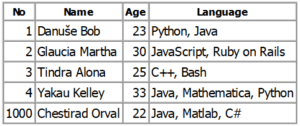
The below mentioned statement creates a table called Employee which contains five columns: EmpID, Name, City, Age and Salary in which auto-increment is applied on column EmpID. In other words, the purpose of AUTOINCREMENT is to prevent the reuse of ROWIDs from previously deleted rows. Autoincrement IDs are a convenient way to create unique identifiers for each row in a database table. If the AUTOINCREMENT keyword appears after INTEGER PRIMARY KEY, that changes the automatic ROWID assignment algorithm to prevent the reuse of ROWIDs over the lifetime of the database. This is true regardless of whether or not the AUTOINCREMENT keyword is used. On an INSERT, if the ROWID or INTEGER PRIMARY KEY column is not explicitly given a value, then it will be filled automatically with an unused integer, usually one more than the largest ROWID currently in use. In SQLite, a column with type INTEGER PRIMARY KEY is an alias for the ROWID (except in WITHOUT ROWID tables) which is always a 64-bit signed integer. The AUTOINCREMENT keyword imposes extra CPU, memory, disk space, and disk I/O overhead and should be avoided if not strictly needed. In fact, it is created when the first table with. It can be applied to a field when creating a table. The SQLite internal table sqlitesequence is used to store information about SQLite: autoincrement columns. The AUTOINCREMENT keyword can be used with INTEGER PRIMARY KEY field only. The ones that haven’t were the ones with trailing commas.The SQLite AUTOINCREMENT is a keyword used for auto incrementing a value of a field in the table. tables (in sqlite3’s interactive mode) and it will prove that both users and settings have been created. Running your original sql, you can introspect the database with. Wh0 is right, you need to trim the trailing commas from lines 26 and 36 only.


No luck: Error: near line 2: near "username": syntax errorĮrror: near line 15: table posts already existsĮrror: near line 29: table comments already existsĮrror: near line 39: table settings already existsĮrror: near line 49: no such table: usersĮrror: near line 50: NOT NULL constraint failed: posts.lastEdited SQLite Database Analyzer (sqlite3analyzer.exe) This stand-alone program reads an SQLite database and outputs a file showing the space used by each table and index and. the clauses GLOB and glob have the same meaning in SQLite statements. Command-Line Shell (sqlite3.exe) Notes on using the 'sqlite3.exe' command-line interface that can be used to create, modify, and query arbitrary SQLite database files. Case Sensitivity The important point to be noted is that SQLite is case insensitive, i.e. Whenever you create a table without specifying the WITHOUT ROWID option, you get an implicit auto-increment column called rowid. This chapter lists all the basic SQLite Syntax. What mistake did I make in the SQL statements? Summary: in this tutorial, you will learn about SQLite AUTOINCREMENT column attribute and when to use it in your table. SQLite AUTOINCREMENT CREATE TABLE people ( firstname TEXT NOT NULL, lastname TEXT NOT NULL ) INSERT INTO people (firstname, lastname) VALUES(John, Doe. Using mysql2sqlite gives me this error: Error: near line 4: near ",": syntax errorĮrror: near line 45: no such table: usersĮrror: near line 46: NOT NULL constraint failed: posts.lastEdited Running cat init.sql | sqlite3 database.sqlite shows this error: Error: near line 15: near ")": syntax errorĮrror: near line 29: near ")": syntax errorĮrror: near line 50: no such table: posts

So I tried importing this into sqlite - Create the users table


 0 kommentar(er)
0 kommentar(er)
